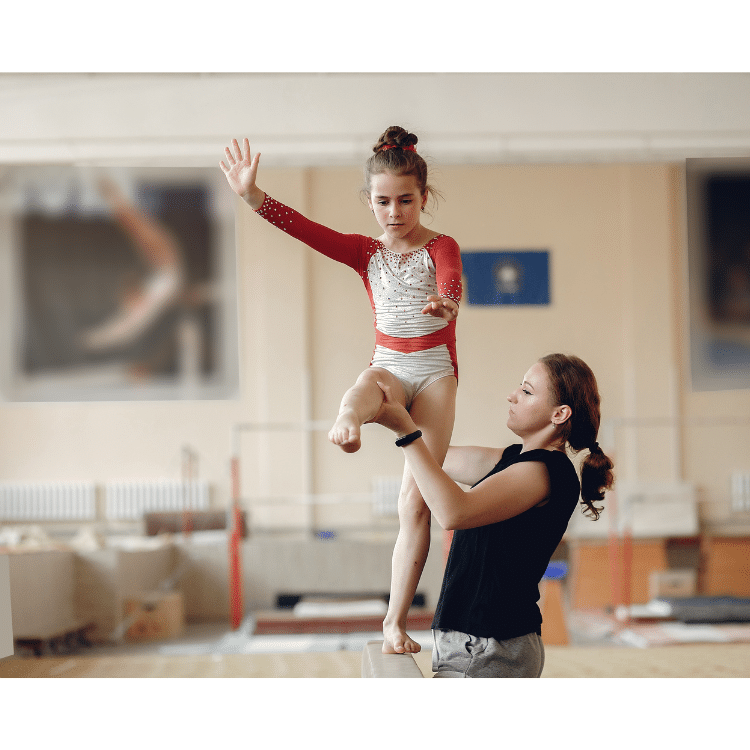
Is Gymnastics harder than cheer? They are two physically demanding sports that require a great deal of skill, strength, and dedication. Both sports have been around for decades and continue to be popular, attracting thousands of participants every year.
In this article, we’ll take a closer look at both gymnastics and cheerleading to see how they compare and what makes each one so challenging.
Key Takeaways
- Gymnastics requires immense physical strength, mental toughness, and years of dedicated practice.
- Cheerleading combines dance and tumbling, demanding strength, flexibility, and team coordination.
- Tumbling skills vary significantly in complexity between gymnastics and cheerleading.
Gymnastics: A Test of Strength and Flexibility
Gymnastics is a sport that demands a combination of physical and mental toughness.
The sport is organized into 11 different disciplines including the popular Men’s and Women’s Artistic, Rhythmic and Tumbling categories.
Each discipline requires varying levels of strength, flexibility, and coordination, as gymnasts master individual skills that are eventually included in competitive routines.

Artistic gymnasts compete on apparatus including bars and vault which require explosive strength and power.
One of the biggest challenges in gymnastics is the relatively young age at which gymnasts often retire. It means that young gymnasts are subject to intense training sessions as they aim to master the high level of skills needed to be successful.
This elite level of training takes a lot of commitment, and even then, gymnasts must always strive for improvement.
Cheerleading: A Combination of Dance and Tumbling
Cheerleading is a sport that combines dance and tumbling, as cheerleaders perform a series of cheers, stunts, and pyramids to support their team.
Cheerleading requires a great deal of strength, flexibility, and coordination, as cheerleaders must lift, toss, and catch each other with precision.

In addition to these skills, cheerleaders must have a high level of endurance, as routines last several minutes and are quick and demanding.
One of the biggest challenges in cheerleading is the level of trust required. Cheerleaders must trust each other completely, as their safety and success depend on their ability to work together as a team. This level of trust takes years of training and practice to develop, and even then, cheerleaders must always be aware of each other and work together seamlessly.
Cheerleading Stunts
Cheerleading stunts can vary in difficulty, and the hardest stunts depend on individual skill level and experience. However, here are some of the most challenging stunts in cheerleading:
- Full-Up Extension: A full-up extension is a stunt where the flyer is lifted up to an extended position and then lowered back down by the bases. This stunt requires a great deal of strength, coordination, and trust from both the flyer and the bases.
- Liberty: A liberty is a stunt where the flyer stands on one base’s shoulder while the other base holds the flyer’s foot. This stunt requires a lot of trust, coordination, and strength from all participants.
- Basket Toss: A basket toss is a stunt where the flyer is thrown into the air and then caught by the bases. This stunt requires a great deal of trust, coordination, and strength from all participants, and it can be especially challenging for flyers who are lighter.
- Heel Stretch: A heel stretch is a stunt where the flyer is lifted into the air and then stretches their legs back and down while being supported by the bases. This stunt requires a great deal of trust, coordination, and strength from all participants.
- Double Down: A double down is a dismount where two flyers are caught by the bases and then lowered to the ground. This stunt requires a lot of trust, coordination, and strength from all participants.
Even the best gymnasts would find it difficult to learn the harder stunts in cheer but the levels of strength and conditioning required in gymnastics would help considerably.
Tumbling difficulty levels compared
Tumbling is a big aspect of both gymnastics and cheerleading, and many of the individual skills cross over between the two.

In the highest levels of cheerleading, harder tumbling passes include:
- Double full twists
- Double somersaults
- Arabian Somersaults
- Multiple Back Handsprings
The same Tumbling skills would be considered fairly straightforward in elite gymnastics. In fact, the highest level gymnasts compete tumbles including:
- Triple somersaults
- Triple twists
- Multiple twisting somersaults
Gymnastics undoubtedly contains harder tumbling skills but some factors should be taken into consideration.
- Cheerleaders often need to choreograph their tumbles to synchronize with others around them.
- Cheerleaders wear shoes compared to barefoot gymnasts (it’s harder to tumble in shoes).
- Gymnastics floors and tumble tracks are often bouncier than the floors that cheerleaders use.
Training Hours
The number of hours per week that cheerleaders train can vary greatly depending on their skill level, competition schedule, and personal goals. On average, competitive cheerleaders can train anywhere from 10 to 20 hours per week, although some may train more or less.
Some elite cheerleaders may train as many as 30 hours per week or more, while others may only train a few hours per week if they are just starting out or are not competing at a high level.
The amount of training also depends on factors such as the age and skill level of the cheerleader, as well as the type of cheerleading they are participating in (e.g. all-star, school, or recreational).
In comparison, elite gymnasts train up to 40 hours per week.
Not all gymnasts will train as intensively as this and there will be plenty of gymnasts at lower levels that train only for only a fraction of this amount.
The Physical and Mental Demands of Gymnastics
Gymnastics stands out for its rigorous physical and mental requirements. Gymnasts must possess exceptional balance, coordination, and strength. The physical demands are evident in the need for precise control in movements, whether on the floor, vault, bars, or beam.
Mental toughness is equally crucial. Gymnasts face intense pressure to perform complex routines flawlessly, often in highly competitive environments. The mental resilience required to train and compete at high levels, coupled with the physical strain, makes gymnastics one of the most demanding sports.
The Risks and Rewards of Cheerleading
Cheerleading, traditionally seen as a supportive activity at sports events, has evolved into a competitive sport with its own set of risks and rewards. It combines elements of dance, gymnastics, and acrobatics, requiring cheerleaders to execute complex stunts and routines.
The physical demands in cheerleading are significant, with a high risk of injuries from stunts and tumbling. However, the rewards are equally compelling. Cheerleading offers a sense of teamwork and camaraderie, as well as the thrill of performing in front of large audiences.
Public Perception and Misconceptions
Both gymnastics and cheerleading often face misconceptions. Gymnastics is sometimes viewed as an individualistic sport focused solely on physical skills, while cheerleading is often underestimated and stereotyped as a less serious sport.
In reality, gymnastics requires a strong sense of discipline and mental strength, and cheerleading demands a high level of athleticism and skill. Both sports deserve recognition for their unique challenges and the dedication required from their athletes.
The Verdict: Which is Harder?
Ultimately, it is difficult to determine which sport is harder, as both gymnastics and cheerleading have their own unique challenges. Whether it’s the level of precision required in gymnastics or the level of trust required in cheerleading, both sports require a great deal of skill, strength, and dedication.
Whether you’re a gymnast or a cheerleader, you know the level of hard work and dedication that goes into each sport.
So, the next time someone asks you is gymnastics harder than cheer, you can proudly say that both are incredibly challenging, and that’s what makes them so rewarding.
FAQs
What is the hardest cheer move?
The Two and Half High Pyramid is arguably the hardest stunt in cheer. In total, it measures the height of two and a half people and requires a lot of trust from the flyers at the top.
Is Dancing harder than cheerleading?
Cheerleading involves a lot of dancing so there’s not a straightforward answer. Cheerleading also includes tumbling and acro which are not found in many types of dance. The additional factors arguably make cheerleading harder.
Is 13 too late to start cheer?
There’s no need to start cheer at a young age like in gymnastics. It’s fine to start cheer at 13 as long as you are prepared to work hard and master the tough skills needed to become a cheerleader.
- How to Do a Back Handspring: Complete Step-by-Step GuideLearning how to do a back handspring is an exciting milestone for any gymnast. It builds confidence, agility, and forms the foundation for advanced tumbling… Read more: How to Do a Back Handspring: Complete Step-by-Step Guide
- How To Get Over a Mental Block In Gymnastics: A Complete GuideGymnastics is a sport that requires not only physical strength and skill but also mental strength. When a gymnast feels like they cannot attempt a… Read more: How To Get Over a Mental Block In Gymnastics: A Complete Guide
- The Best Leotard for Girls in 2025: What to Look ForFinding an ideal leotard for girls isn’t just about picking a dazzling design that sparkles (although it does help!). The leotard has to fit perfectly,… Read more: The Best Leotard for Girls in 2025: What to Look For
- The Best Gymnastics Shorts (Our Top Picks)The best gymnastics shorts are designed to be worn over the top of a leotard providing additional coverage around the upper legs, whilst allowing gymnasts… Read more: The Best Gymnastics Shorts (Our Top Picks)
- Decathlon Leotards – Are They Any Good?If you’re in the market for a new leotard, you may be wondering if Decathlon leotards are any good considering the low cost of their… Read more: Decathlon Leotards – Are They Any Good?
- A Complete Guide to Gymnastics Hand RipsAre you tired of dealing with painful gymnastics rips on your hands from training? Look no further – this article offers a comprehensive approach to… Read more: A Complete Guide to Gymnastics Hand Rips






